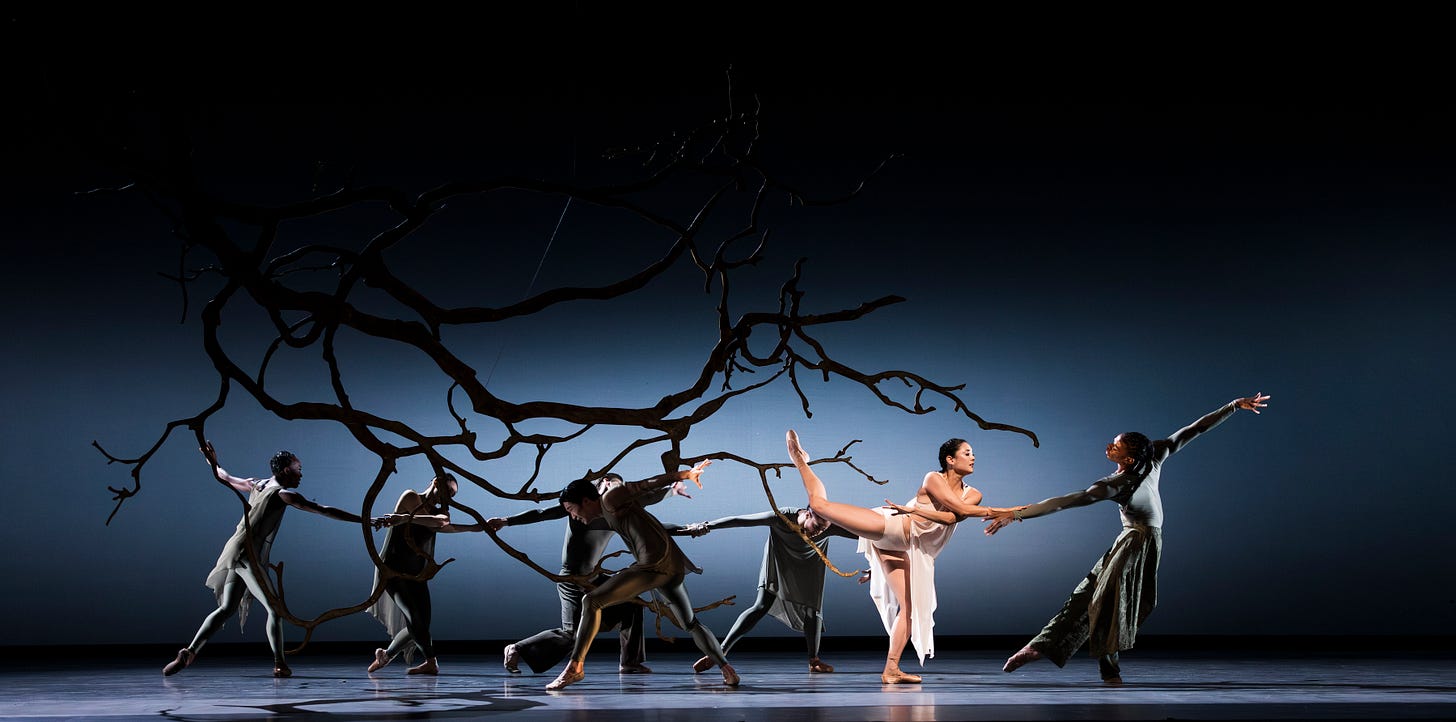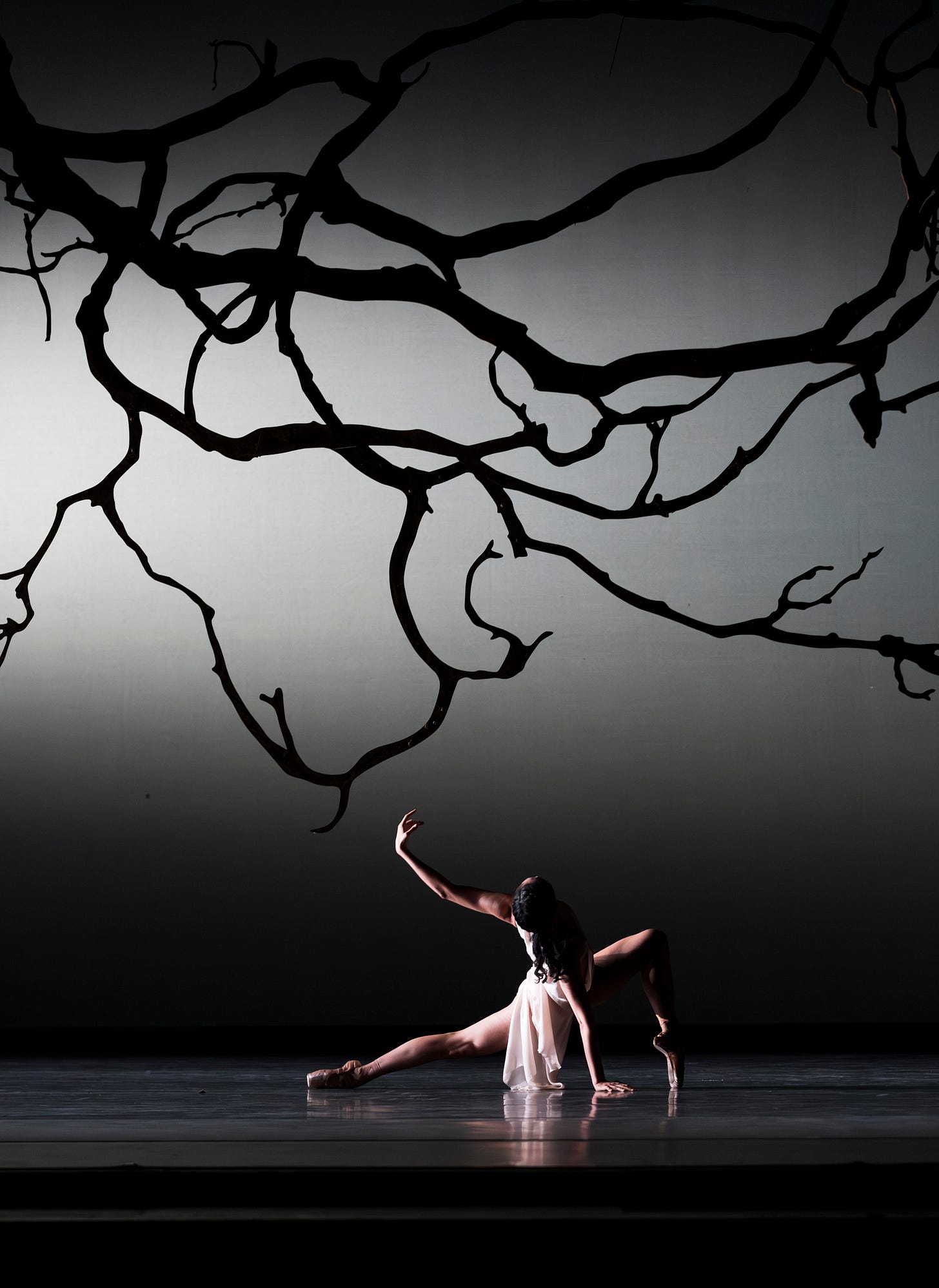
Pacific Northwest Ballet Artistic Director Peter Boal once told me that he wanted his audiences to get to know new choreographers. He didn’t mean just one ballet here and there; Boal wanted to build up significant repertoires from choreographers like Crystal Pite, Twyla Tharp and William Forsythe. And in his 20-year Seattle tenure, he’s done that. But Boal also has brought in perhaps less famous creators, people like Robin Mineko Williams, or Alejandro Cerrudo, who finished a stint as PNB’s choreographer-in-residence last season.
Kent Stowell and Francia Russell steeped PNB in works by George Balanchine and Stowell himself, although they also acquired contemporary works. But when Boal replaced them, I remember thinking that he blew the roof off of PNB’s performance home, McCaw Hall, offering audiences dances by David Parsons, Susan Marshall, Molissa Fenley and many other young dancemakers.

The company’s 2024-25 season opened September 20 at McCaw Hall with the debut of a new work by a new choreographer-in-residence, Jessica Lang. She’s no stranger to either PNB or the wider dance community (PNB first presented her solo, The Calling in 2015). Her latest creation for this company builds on a body of work that demands both technical and emotional prowess. Lang began her career as a contemporary dancer, and her new creation embraces those roots while seating them in the world of ballet.
Black Wave, with music by Salina Fisher, sets by Libby Stadstad and glorious costumes designed by Jillian Lewis, both burnishes Lang’s Northwest reputation and more firmly ties her ballet repertoire to her many years in the contemporary dance world. Lang headed an eponymous company from 2011 to 2019; before that she danced with Twyla Tharp’s company. Black Wave might have been the program’s most intellectually rigorous piece, but also an exciting auger for ballet’s future, bringing us a fresh way to contemplate what some people call a heritage art form.

Black Wave, ensconced between Edwaard Liang’s visually arresting The Veil Between Worlds and Justin Peck’s super high energy The Times Are Racing, is far more somber than either of those two crowd pleasers. According to the program notes, it’s a meditation on mental health and an ancient Japanese practice of repairing broken pottery with gold lacquer, so that something treasured that has cracked can be rendered into something different but equally beautiful.
The ballet begins with the stage in a murky gray haze, with a dancer, Leah Terada in the performance I saw, wreathed in a filmy white dress. She stands at the rear of the stage, moving her head from side to side, in a persistent and jagged rhythm. Other dancers, clad in blues and grays, soon join her onstage: Leta Biasucci and Dylan Wald in bright light blue, newly promoted soloist Luther DeMyer with Sarah-Gabrielle Ryan in dark blue, plus Kuu Sakuragi who seems to be Terada’s estranged partner. There are also five gray-draped dancers who seemed like specters drifting around the stage under a huge bare tree branch. These dancers all splay their fingers, or move arms and legs in angular, repetitive motions. Terada moves among them, but not with them. Choreographer Lang isn’t telling a narrative story here, but I couldn’t take my eyes off the action onstage. Clearly Terada was in pain; just as clearly the gray-clad specters haunted her. How would this resolve?
My companion, not a regular ballet goer, was a bit taken aback by the darkness of this dance, especially after the cheery beauty of Liang’s opulent colors, accented by huge fabric swaths in red, orange and gold that billow from the wings across the stage and over the dancers. I enjoyed watching his “Veil Between Worlds”, most especially the generous duet performed by veteran principal dancers Lucien Postlewaite and Leta Biasucci. Postlewaite is always technically proficient but what stands out is his emotional connection to his partners and what I can only describe as a generosity of movement and his innate musicality. When he extends his hand, you see it move a little further, his fingers curving to beckon Biasucci closer. She responds in kind. They know when to pause just a second longer than the music’s beat, creating a dramatic tension that the choreography might not require, but their artistic choices augment. They’ve developed their artistic sensibilities in part by their years immersed in the art form. This was one of Liang’s lingering moments of pure beauty.

But while I enjoyed this work, I remember bits and pieces of it like a series of beautiful, but not fully connected, vignettes. I love to watch and savor those gorgeous dancers: Dammiel Cruz, Ashton Edwards, Biasucci and Postelwaite all deliver. But like the ephemeral delicacy of a firefly, the moments they deliver faded to black, literally and in my memory.
Terada and her castmates in Black Wave have more inherently dramatic choreography to elaborate on. Like my friend, some in the audience might have found Fisher’s score jarring, the percussive movements lacking the sumptuous spark of Liang’s floating fabric. But as Lang’s dance built to its conclusion, I marveled at its sophistication, at how the structure of her dance amplified the beauty of the movements she’d strung together. I fell under her spell, marveling at the skill it takes to make something that takes a viewer from a start to a conclusion. Black Wave wasn’t merely eye candy, but an artwork with something very nuanced to convey. Bravo!
The program’s last ballet, Peck’s The Times Are Racing, made its Seattle debut in 2022 and was warmly welcomed back this year by the audience. The large cast of 20, clad in street clothes and white sneakers, radiated youthful energy and a zest for living, the kind of joy you feel on a summer day at the park. It’s primarily a work for the large ensemble but two couples stood out: Elle Macy and Luther DeMyer dancing a slinky quasi-romantic pas de deux, and Noah Martzall and Amanda Morgan, who deliver a dazzling cocktail of tap and ballet.
Martzall is the kind of dancer who brings strength and precision to everything he does while Morgan, all long arms and legs, combines grace and joy in Peck’s fizzy ballet. Her energy seems to fly through the ends of her loose hair down her body to her tapping feet. She and Martzall are friends and you could see their rapport in this duet. And watching Macy, who was probably the oldest dancer onstage. all of age 30 or so, kicking it with the kids? She never fails to impress. I wish I still had the energy.
My friend and I left the theater feeling energized, but contemplating the program the next day I still find myself most drawn to Black Wave’s complexity, thinking about how we define what’s exquisite and how a different type of beauty can emerge from something broken then repaired. All three ballets on this bill offer things for me to admire; Lang’s Black Wave also offered something to think about: how we consider the future of ballet, and how contemporary choreographers like Lang, Peck and Liang will help define it.
You can, and should, see this program, The Times Are Racing, Thurs. Sept. 26-Sun. Sept 29 at Marion Oliver McCall Hall. Thursday is a pay-what-you-will performance.





